
Pyrrhocoridae is a family of insects with more than 300 species world-wide. Many are red coloured and are known as red bugs and some species are called cotton stainers because their feeding activities leave an indelible yellow-brownish stain on cotton crops. A common species in parts of Europe is the firebug, and its genus name Pyrrhocoris and the family name are derived from the Greek roots for fire "pyrrho-" and bug "coris". Members of this family are often confused with, but can be quickly separated from, Lygaeidae by the lack of ocelli on the top of the head.
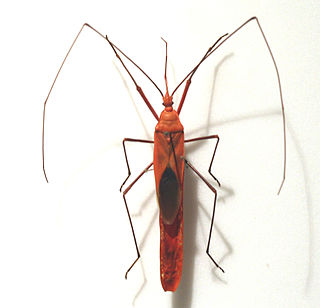
Macrocheraia is a genus of bugs in the family Largidae with a single species, Macrocheraia grandis found mainly in Southeast Asia but extending into parts of South Asia. This was referred to in some older literature under the genus Lohita, a name derived from the Sanskrit word for red.
Raxa is a genus of true bugs in the family Pyrrhocoridae. Unlike most pyrrhocorids, members of this genus are predatory, rather than herbivorous.

Pyrrhocoris is a genus of true bugs in the family Pyrrhocoridae, the cotton stainers.
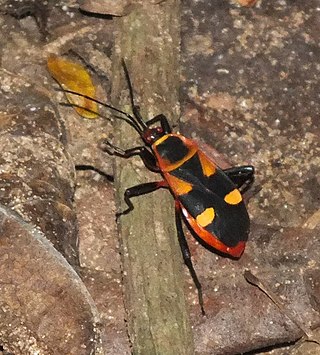
Roscius is an Afrotropical genus of true bugs in the family Pyrrhocoridae, the cotton stainers. They are often confused with bugs in the family Lygaeidae, such as the genus Oncopeltus, but can be distinguished by the lack of ocelli on the head.

Dysdercus is a widespread genus of true bugs in the family Pyrrhocoridae; a number of species attacking cotton bolls may be called "cotton stainers".
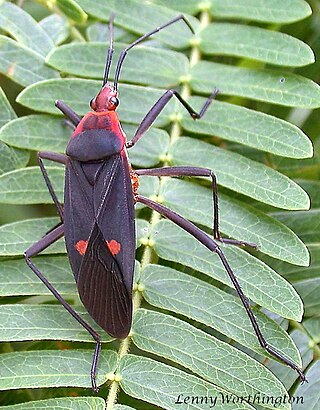
Melamphaus is an Old World genus of true bugs in the family Pyrrhocoridae, the cotton stainers. They are often confused with bugs in the family Lygaeidae, but can be distinguished by the lack of ocelli on the head.
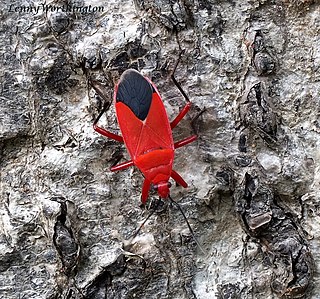
Antilochus coquebertii is an Old World species of true bug in the family Pyrrhocoridae, occurring in South and Southeast Asia. It is brightly coloured, red and black, and is a beneficial predator on other pyrrhocorids, especially the genus Dysdercus, which are crop pests. They are often confused with bugs in the family Lygaeidae, but can be distinguished by the lack of ocelli on the head, and they can be easily distinguished from Dysdercus by the lack of white stripes on the body. They are known to be cannibalistic in nature, but are not known to prey on human flesh or blood.
Antilochus was the son of Nestor, king of Pylos, in Greek mythology.

Neacoryphus is a genus of seed bugs in the family Lygaeidae. There are about five described species in Neacoryphus.

Neortholomus is a genus of seed bugs in the family Lygaeidae. There are about nine described species in Neortholomus.

Scantius aegyptius, the Mediterranean red bug, is a species of red bug in the family Pyrrhocoridae, that is a pest of plant species in the family Malvaceae.

Scantius is a genus of mostly African and European bugs in the family Pyrrhocoridae. There are at least two described species in Scantius.

Kleidocerys is a genus of seed bugs in the family Lygaeidae. There are about 17 described species in Kleidocerys.

Berytinus is a genus of stilt bugs in the family Berytidae. There are about 12 described species in Berytinus.
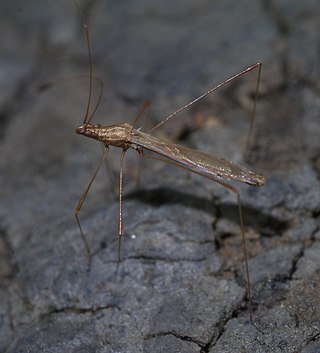
Jalysus is a genus of stilt bugs in the family Berytidae. There are about 12 described species in Jalysus.
Hoplinus is a genus of stilt bugs in the family Berytidae. There are about six described species in Hoplinus.

Xyonysius is a genus of seed bugs in the family Lygaeidae. There are about eight described species in Xyonysius.
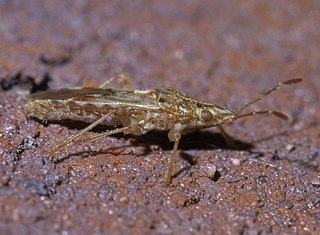
Belonochilus is a genus of seed bugs in the family Lygaeidae. There is one described species in Belonochilus, B. numenius, the sycamore seed bug, making it a monotypic genus.

Anochrostomus is a genus of seed bugs in the family Lygaeidae. There are at least two described species in Anochrostomus.
















